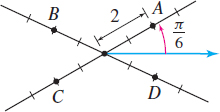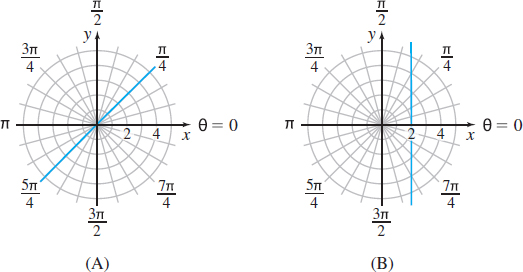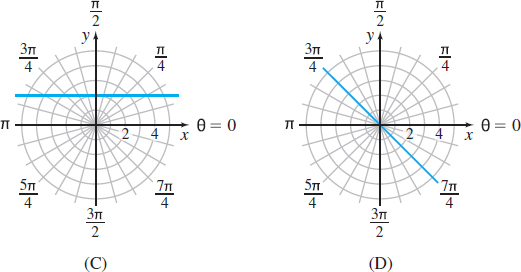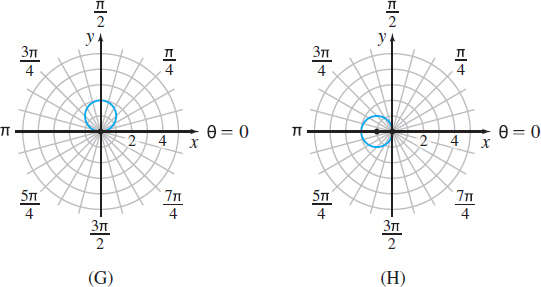9.4 Assess Your Understanding
668
Concepts and Vocabulary
Question
In a polar coordinate system, the origin is called the ______________, and the ______________ coincides with the positive \(x\)-axis of the rectangular coordinate system.
Question
True or False Another representation in polar coordinates for the point \(\left( 2,\dfrac{\pi }{3}\right)\) is \(\left( 2,\dfrac{4\pi }{3}\right) .\)
Question
True or False In a polar coordinate system, each point in the plane has exactly one pair of polar coordinates.
Question
True or False In a rectangular coordinate system, each point in the plane has exactly one pair of rectangular coordinates.
Question
True or False In polar coordinates \(( r,\theta)\), the number \(r\) can be negative.
Question
True or False If \(( r,\theta )\) are the polar coordinates of the point \(P,\) then \(\vert r\vert\) is the distance of the point \(P\) from the pole.
Question
To convert the point \(( r,\theta )\) in polar coordinates to a point \(( x,y)\) in rectangular coordinates, use the formulas \(x=\)______________ and \(y=\)______________.
Question
An equation whose variables are polar coordinates is called a(n) ____________________________ .
Skill Building
In Problems 9–16, match each point in polar coordinates with A, B, C, or D on the graph.

Question
\(\left( 2,-\dfrac{11\pi }{6}\right)\)
Question
\(\left(-2,-\dfrac{\pi }{6}\right)\)
Question
\(\left( -2,\dfrac{\pi }{6}\right)\)
Question
\(\left( 2,\dfrac{7\pi }{6}\right)\)
Question
\(\left( 2,\dfrac{5\pi }{6}\right)\)
Question
\(\left(-2,\dfrac{5\pi }{6}\right)\)
Question
\(\left( -2,\dfrac{7\pi }{6} \right)\)
Question
\(\left( 2,\dfrac{11\pi }{6}\right)\)
In Problems 17–24, polar coordinates of a point are given. Plot each point in a polar coordinate system.
Question
\(\left( 4,\dfrac{\pi }{3}\right)\)
Question
\(\left( -4,\dfrac{\pi }{3}\right)\)
Question
\(\left( -4,-\dfrac{\pi }{3}\right)\)
Question
\(\left( 4,-\dfrac{\pi }{3}\right)\)
Question
\(\left( \sqrt{2},\dfrac{\pi }{4}\right)\)
Question
\(\left( 7,-\dfrac{7\pi }{4}\right)\)
Question
\(\left( -6,\dfrac{4\pi }{3}\right)\)
Question
\(\left( 5,\dfrac{\pi }{2}\right)\)
669
In Problems 25–32, polar coordinates of a point are given. Find other polar coordinates \(( r,\theta )\) of the point for which:
(a) \(r>0,\;-2\pi \leq \theta <0\)
(b) \(r<0,\;0\leq \theta <2\pi\)
(c) \(r>0,\;2\pi \leq \theta <4\pi\)
Question
\(\left( 5,\dfrac{2\pi }{3}\right)\)
Question
\(\left( 4,\dfrac{3\pi }{4}\right)\)
Question
\(( -2,3\pi )\)
Question
\((-3,4\pi )\)
Question
\(\left( 1,\dfrac{\pi }{2}\right)\)
Question
\(( 2,\pi )\)
Question
\(\left( -3,-\dfrac{\pi }{4}\right)\)
Question
\(\left( -2,-\dfrac{2\pi }{3}\right)\)
In Problems 33–40, polar coordinates of a point are given. Find the rectangular coordinates of each point.
Question
\(\left( 6,\dfrac{\pi }{6}\right)\)
Question
\(\left( -6,\dfrac{\pi }{6}\right)\)
Question
\(\left( -6,-\dfrac{\pi }{6}\right)\)
Question
\(\left( 6,-\dfrac{\pi }{6}\right)\)
Question
\(\left( 5,\dfrac{\pi }{2}\right)\)
Question
\(\left( 8,\dfrac{\pi }{4}\right)\)
Question
\(\left( 2\sqrt{2},-\dfrac{\pi }{4}\right)\)
Question
\(\left( -5,-\dfrac{\pi }{3}\right)\)
In Problems 41–50, rectangular coordinates of a point are given. Plot the point. Find polar coordinates \(( r,\theta )\) of each point for which \(r>0\) and \(0\leq \theta <2\pi\).
Question
\(( 5,0)\)
Question
\(( 2,-2)\)
Question
\((-2,2)\)
Question
\(( -2,-2\sqrt{3})\)
Question
\(( \sqrt{3},1)\)
Question
\((0,-3)\)
Question
\(( -\sqrt{3},1)\)
Question
\(( 3\sqrt{2},-3\sqrt{2})\)
Question
\(( 3,2)\)
Question
\(( -6.5,1.2)\)
In Problems 51–58, match each of the graphs (A) through (H) to one of the following polar equations.




Question
\(r=2\)
Question
\(\theta = \dfrac{\pi }{4}\)
Question
\(r=2\cos \theta\)
Question
\(r\cos \theta =2\)
Question
\(r=-2\cos \theta\)
Question
\(r=2\sin \theta\)
Question
\(\theta =\dfrac{3\pi }{4}\)
Question
\(r\sin \theta =2\)
In Problems 59–74, identify and graph each polar equation. Convert to a rectangular equation if necessary.
Question
\(r=4\)
Question
\(r=2\)
Question
\(\theta =\dfrac{\pi }{3}\)
Question
\(\theta =-\dfrac{\pi }{4}\)
Question
\(r\sin \theta =4\)
Question
\(r\cos \theta =4\)
Question
\(r\cos \theta =-2\)
Question
\(r\sin \theta =-2\)
Question
\(r=2\cos \theta\)
Question
\(r=2\sin \theta\)
Question
\(r=-4\sin \theta\)
Question
\(r=-4\cos \theta\)
Question
\(r\sec \theta =4\)
Question
\(r\csc \theta =8\)
Question
\(r\csc \theta =-2\)
Question
\(r\sec \theta =-4\)
In Problems 75–82, the letters \(x\) and \(y\) represent rectangular coordinates. Write each equation in polar coordinates \(r\) and \(\theta\).
Question
\(\dfrac{x^{2}}{4}+\dfrac{y^{2}}{9}=1\)
Question
\(x-4y+4=0\)
Question
\(x^{2}+y^{2}-4x=0\)
Question
\(y=-6\)
Question
\(x^{2}=1-4y\)
Question
\(y^{2}=1-4x\)
Question
\(xy=1\)
Question
\(x^{2}+y^{2}-2x+4y=0\)
In Problems 83–94, the letters \(r\) and \(\theta\) represent polar coordinates. Write each equation in rectangular coordinates \(x\) and \(y\).
Question
\(r=\cos \theta\)
Question
\(r=2+\cos \theta\)
Question
\(r^{2}=\sin \theta\)
Question
\(r^{2}=1-\sin \theta\)
Question
\(r=\dfrac{4}{1-\cos \theta }\)
Question
\(r=\dfrac{3}{3-\cos \theta }\)
Question
\(r^{2}=\theta\)
Question
\(\theta =-\dfrac{\pi }{4}\)
Question
\(r=2\)
Question
\(r=-5\)
Question
\(\tan \theta =4\)
Question
\(\cot \theta =3\)
670
Applications and Extensions
Question
Chicago In Chicago, the road system is based on a rectangular coordinate system, with the intersection of Madison and State Streets at the origin, and east as the positive \(x\)-axis. Intersections are indicated by the number of blocks they are from the origin. For example, Wrigley Field is located at 1060 West Addison, which is 10 blocks west of State Street and 36 blocks north of Madison Street.
- Write the location of Wrigley Field using rectangular coordinates.
- Write the location of Wrigley Field using polar coordinates. Use east as the polar axis.
- U.S. Cellular Field is located at 35th Street and Princeton, which is 3 blocks west of State Street and 35 blocks south of Madison Street. Write the location of U.S. Cellular Field using rectangular coordinates.
- Write the location of U.S. Cellular Field using polar coordinates.
Question
Show that the formula for the distance \(d\) between two points \(P_{1}=(r_{1},~\theta _{1})\) and \(P_{2}=(r_{2},~\theta _{2})\) is \[ \begin{equation*} d=\sqrt{r_{1}^{2}+r_{2}^{2}-2r_{1}r_{2}\cos (\theta _{2}-\theta _{1})} \end{equation*} \]
Question
Horizontal Line Show that the graph of the equation \(r\sin \theta =a\) is a horizontal line \(a\) units above the pole if \(a>0\), and \(|a|\) units below the pole if \(a<0\).
Question
Vertical Line Show that the graph of the equation \(\ r\cos \theta =a\) is a vertical line \(a\) units to the right of the pole if \(a>0\), and \(|a|\) units to the left of the pole if \(a<0\).
Question
Circle Show that the graph of the equation \(r=2a\sin \theta,\;a>0\), is a circle of radius \(a\) with its center at the rectangular coordinates \((0, a)\).
Question
Circle Show that the graph of the equation \(r=-2a\sin \theta ,\) \(a>0\), is a circle of radius \(a\) with its center at the rectangular coordinates \((0,\,-a)\).
Question
Circle Show that the graph of the equation \(r=2a\cos \theta ,\) \(a>0\), is a circle of radius \(a\) with its center at the rectangular coordinates \((a, 0)\).
Question
Circle Show that the graph of the equation \(r=-2a\cos \theta ,a>0\), is a circle of radius \(a\) with its center at the rectangular coordinates \((-a, 0)\).
Question
![]() Exploring Using Graphing Technology
Exploring Using Graphing Technology
- Use a square screen to graph \(r_{1}=\sin \theta ,\) \(r_{2}=2\sin \theta\), and \(r_{3}=3\sin \theta .\)
- Describe how varying the constant \(a,\) \(a>0,\) alters the graph of \(r=a\sin \theta\).
- Graph \(r_{1}=-\sin \theta ,\) \(r_{2}=-2\sin \theta ,\) and \(r_{3}=-3\sin \theta .\)
- Describe how varying the constant \(a,\) \(a<0,\) alters the graph of \(r=a\sin \theta\).
Question
![]() Exploring Using Graphing Technology
Exploring Using Graphing Technology
- Use a square screen to graph \(r_{1}=\cos \theta ,\) \(r_{2}=2\cos \theta ,\) and \(r_{3}=3\cos \theta .\)
- Describe how varying the constant \(a,\) \(a>0,\) alters the graph of \(r=a\cos \theta\).
- Graph \(r_{1}=-\cos \theta ,\) \(r_{2}=-2\cos \theta ,\) and \(r_{3}=-3\cos \theta .\)
- Describe how varying the constant \(a,\) \(a<0,\) alters the graph of \(r=a\cos \theta\).
Challenge Problems
Question
Show that \(r=a\sin \theta +b\cos \theta ,\) \(a,\,b\) not both zero, is the equation of a circle. Find the center and radius of the circle.
Question
Express \(r^{2}=\cos ( 2\theta )\) in rectangular coordinates free of radicals.
Question
Prove that the area of the triangle with vertices \((0,0),~(r_{1},\theta _{1}),(r_{2},\theta _{2})\) is \[ \begin{equation*} A=\dfrac{1}{2}r_{1}r_{2}~\sin (\theta _{2}-\theta _{1})\qquad 0\leq \theta _{1}<\theta _{2}\leq \pi \end{equation*} \]
